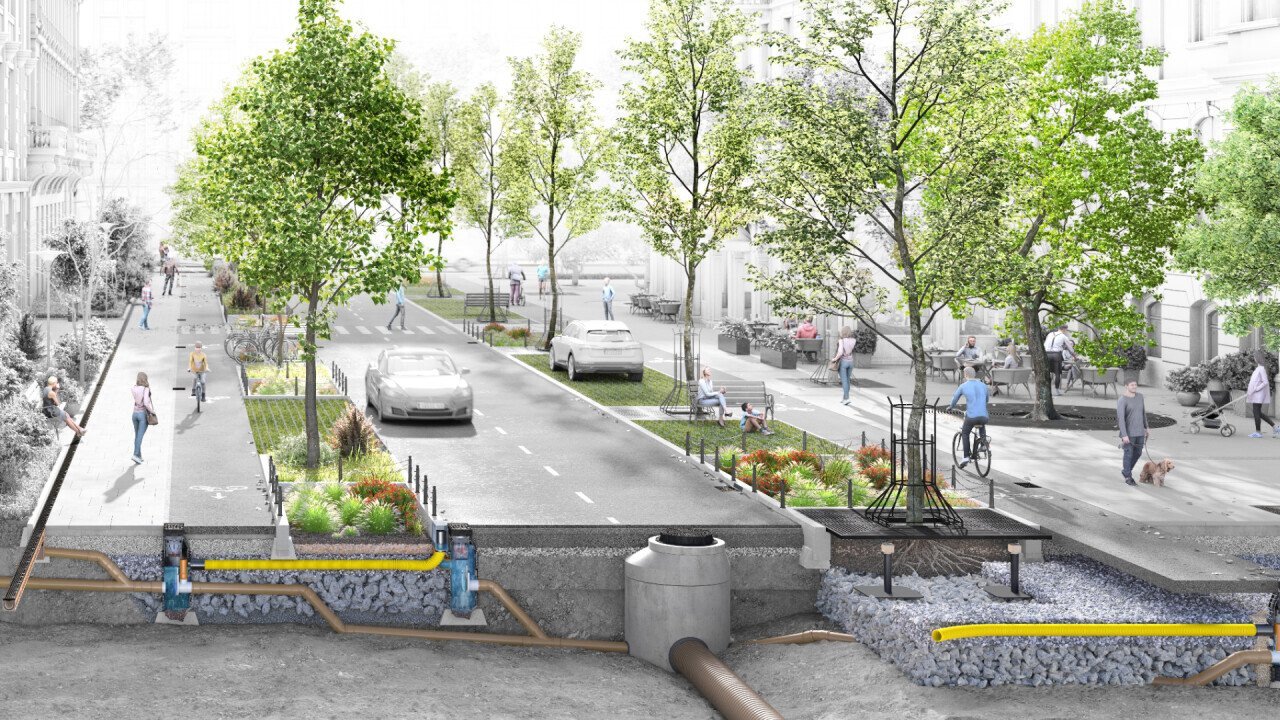Climate change is not a future scenario, but an acute reality. One of the simplest and most effective means of combating the consequences of climate change is urban trees. The sponge city principle for trees is an innovative construction method that ensures the survival of urban trees in the street.
Periods of heat with extreme drought, then heavy rainfall and flooding: Climate change is not a future scenario, but an acute reality. People in cities in particular are suffering from the consequences of global warming. Due to increasing sealing, it is becoming particularly hot in urban centres. Urban heat islands are emerging. At the same time, the risk of flooding increases because rainfall on sealed surfaces does not seep away and the sewerage system reaches its limits.
One of the simplest and most effective means of combating the consequences of climate change are urban trees. They filter and cool the air, absorb CO2, provide shade and absorb a lot of water through their strong roots. But urban trees have a hard time. In order to protect them against long dry periods, insufficient root space and heavy soil compaction, the principle of the sponge city for trees was developed.
The sponge city principle for trees is an innovative construction method that ensures the survival of urban trees in street spaces. Originally developed in Scandinavia, the principle enables the healthy development of large-crowned trees in urban areas and at the same time creates underground retention space for rainwater.
With the help of the sponge city principle, the root system of trees can spread under paved surfaces such as pavements, car parks and roads without causing any damage. The structure of the road substructure must fulfil both the technical requirements of road construction and the biological requirements of trees.
The solution: Innovative design
A coarse stone skeleton ensures the necessary load transfer. Cavities filled with fine-pored substrate between the stones of the substructure supply the trees with water even during dry periods. A positive side effect is that large quantities of water can be stored in the root system and the surrounding soil.

As a locally effective solution, the innovative construction principle of the sponge city is based on many levers and fulfils the requirements of road construction as well as those of urban trees:
- Stability for traffic loads
- Integration of existing infrastructure lines
- Distribution and plant-available storage of discharged surface water
1. Stability for traffic loads
For road construction, the stability, durability and safety of the substructure of pavements and carriageways are top priorities. By distributing the traffic loads over the compacted coarse aggregate, they can be transferred without any problems. The cavities between the stones are filled with a fine substrate that provides both nutrients and a suitable pore structure for the roots of the trees. In this way, the root zone can be extended to the space below pavements and roads and the tree can grow in a healthy way. Additional retention is possible in the cavities of the coarse aggregate.
2. Integration of existing infrastructure lines
The space under footpaths and cycle paths as well as parking and driving areas is much sought after. With the sponge city principle, the tree discs on the surface can be kept smaller, as water and air are made available for the trees under the paved surfaces. This creates more room for manoeuvre for the design of the public space. Sewer, telecommunications, drinking water and district heating pipes also take up space underground and should be planned in from the outset if possible. There are also a number of suitable solutions for integrating existing pipes into the sponge city. This creates more scope for the design of the public space.
3. Distribution and plant-available storage of discharged surface water
The fine substrate introduced into the cavities of the coarse aggregate provides space for tree roots, water and air. After compaction, around 30 % of the total volume is available for this purpose. The average lifespan of street trees of currently approx. 20 - 30 years can thus be extended to at least 80 - 100 years. Infiltration allows the groundwater table to recover, safeguarding valuable drinking water resources. In contrast to other systems, the rainwater in the sponge city is not stored underground, but held in the pores against gravity, i.e. retained, as in natural soil.
Root-hostile stagnant horizons are thus avoided and excess water can slowly seep away. If no fine substrate is used in the sponge city body, which is possible in areas away from trees, up to 300 litres per cubic metre can be temporarily retained. This also reduces the load on the canals and improves the water quality of watercourses in the surrounding urban area.

